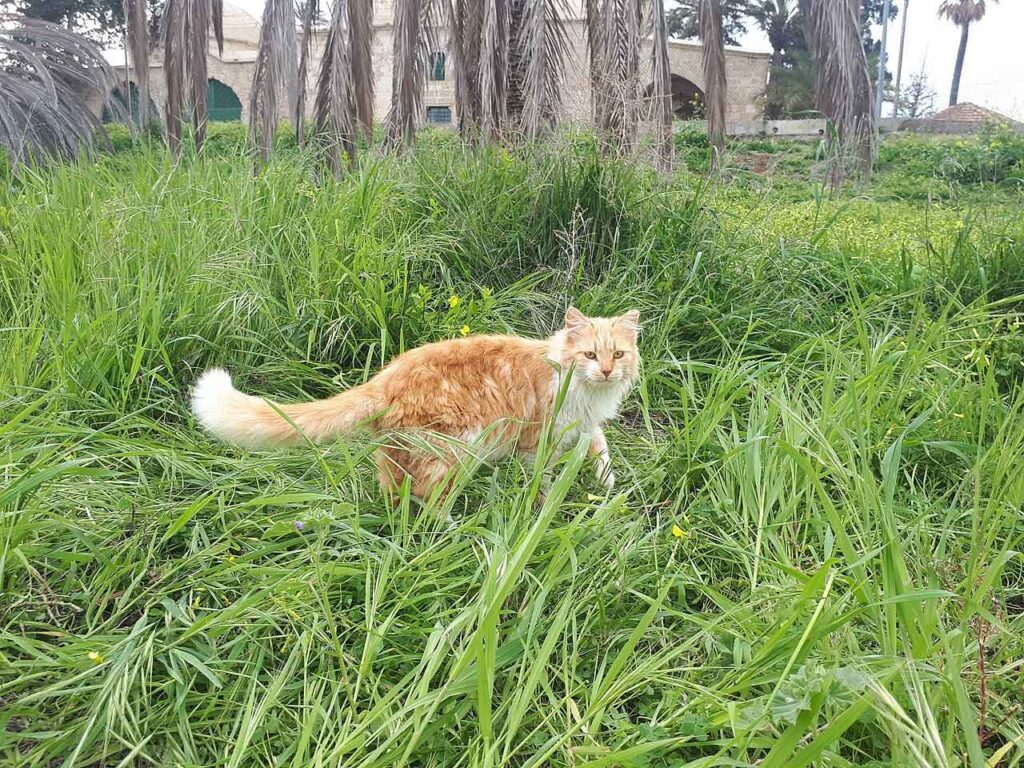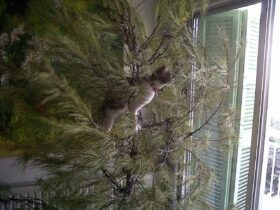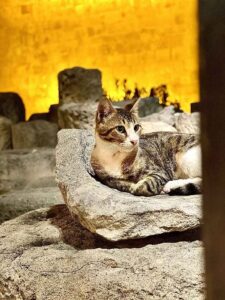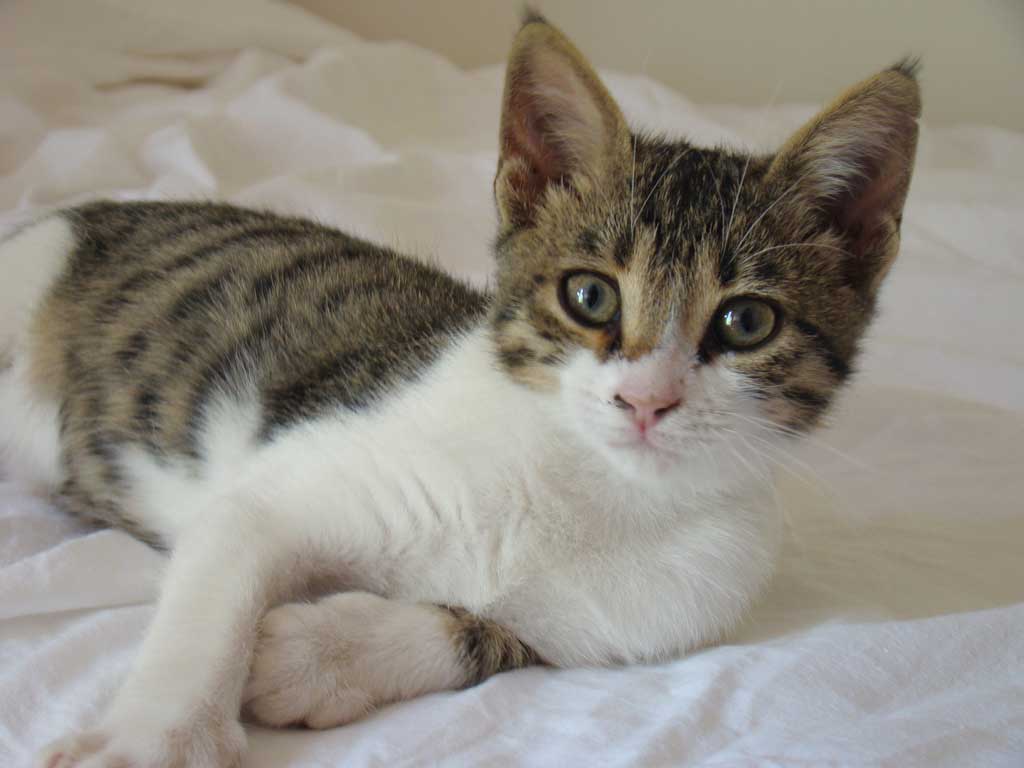Content |
|---|
Characteristics "Cyprus cat (Saint Helen cat)"
Coexistence is important that you have with your new friend. Before considering the acquisition of a cat of the breed "Cyprus cat (Saint Helen cat)" you know certain factors. You must take into account their character, their need for exercise, their interaction with other pets, their care and if you have small children, their level of tolerance towards them.
Joy4.0 out of 5 stars (based on 1 review)
|
Activity level4.0 out of 5 stars (based on 1 review)
|
Kindness to other people4.0 out of 5 stars (based on 1 review)
|
|---|---|---|
Friendliness to children5.0 out of 5 stars (based on 1 review)
|
Grooming requirements2.0 out of 5 stars (based on 1 review)
|
Vocality2.0 out of 5 stars (based on 1 review)
|
Need for attention3.0 out of 5 stars (based on 1 review)
|
Affection towards its owners5.0 out of 5 stars (based on 1 review)
|
Docility2.0 out of 5 stars (based on 1 review)
|
Intelligence4.0 out of 5 stars (based on 1 review)
|
Independence4.0 out of 5 stars (based on 1 review)
|
Robusted3.0 out of 5 stars (based on 1 review)
|
History
The Cyprus cat It is a breed of cat native to the island of Cyprus, located in the Mediterranean Sea, south of turkey. The history of the relationship between Cypriots and cats is very old. In fact, during the excavation of a Neolithic tomb in the village of Shillourokambos in 2004, French archaeologists discovered a cat skeleton buried alongside a human skeleton, dating from about 9500 years before Christ. This discovery was even more important, as it is the oldest evidence of human domestication of cats.
Although the small cats had been present on the island for thousands of years, the race Aphrodite had benefited from many other influences. The first proof of this is found in the Life of Constantine, written towards the year 338 by Bishop Eusebius of Caesarea (235-369) during the reign of the Roman Empress Helen (250-330). It is said that the Roman empress Helena (250-330 d.C.) discovered during a visit to Cyprus that, after a drought 37 years, the island was infested with poisonous snakes, especially around monasteries located in dry and rocky areas. He decided to send hundreds of cats from Egypt by boat to regulate its population. The monasteries took care of the newcomers: they lived around the convents and the monks were in charge of feeding and caring for them.
This tradition continued for centuries, even to this day. In 1484, the Franciscan friar Francesco Suriano, recounting his trip to the Holy Land and his visit to the island and the monastery of San Nicolás de los Gatos, said “it's wonderful to see them, because almost all of them are mutilated by snakes; one has lost a nose, another an ear… And it is curious that when it comes to eating, to the sound of a bell, meet at the monastery; and when they have eaten enough, to the sound of the same bell, they all go out together to fight the snakes.
But not only the Romans brought cats to the island. It was invaded by the Ottomans in 1571 and then occupied by Great Britain in 1878. In both cases, cats were put on board ships to ward off rats and mice. When the ships docked off the shores of Cyprus, some escaped and stayed on the island, mixing and reproducing with the local population.
Most Cypriots have always resented the large cat population on their island. Cats were often abused, killed or poisoned with impunity, what is still happening today.
The beginnings of the breed Aphrodite
In 2005, by chance, an English cat breeder named Teresa Litherland moved to Cyprus. He was shocked by the treatment the cats received there, and at the same time he realized the very different and unique characteristics of many of them. They were large compared to European cats, with long and muscular bodies, hind legs slightly longer than front legs, long bushy tails, triangular heads and fairly large ears. A beautiful cat he named Cassidy and a female he named Lady came soon into his life as they entered his garden.. They were the first breeding pair to create the breed Aphrodite as we know it today. Next, set out to breed them to see if their characteristics were passed on to offspring. That's how it went, and this success convinced her to embark on an ambitious project: getting the Cypriot cat recognized as a breed in its own right.
The recognition of the breed Aphrodite

Of 2005 to 2008, Teresa Litherland produced 4 generations of kittens. Some were big, long or short hair, others were smaller, mostly short haired. In 2008 met Andreas Mobius in Cyprus, international judge of the World Cat Federation (WCF) ⓘ, and presented them. They were all larger than the wild cats of Cyprus and had a truly unique appearance., both in its skeleton and in different features such as the ears, the eyes and the shape of the mouth. Andreas Mobius focused solely on the big cats and came to the conclusion that they did indeed have unique characteristics and that it made sense to continue this project with a view to gaining recognition as a Cyprus cat breed.. Decided to call the race Giant aphrodite in reference to its impressive size and the goddess Aphrodite What, according to legend, was born in the waters of the island.
That same year, in 2008, the Teresa Litherland se le union Lynn Nyland, a friend from England who was also touched by the situation of the local cats and who decided to help her carry out her project. She, too, realized that the best way to improve her situation in the long term, ensuring adequate protection, was to make the locals realize that they had a treasure, some cats that could be the envy of the whole world. the only way to do it, as difficult as it was, was to get the recognition of the race.
In 2009, they created the Cyprus National Cat Association (CyCNBA), that Aphrodite set out to promote. A few months after its creation, became a full member of the World Cat Federation (WCF) ⓘ.
As they continued their work, and still aiming to breed Aphrodite was recognized as a breed in its own right, they sent Dr.. Leslie A. Lyons, from the Laboratory of Feline Genetics, a letter of intent. Lyons, from the Laboratory of Feline Genetics of the University of California, Davis ((UNITED STATES)UU.), I take 248 cat DNA samples, mixing individuals from their breeding program with those they simply cared for. At the beginning of 2012, the geneticist concluded that they form a distinct and unique population.
They also opened their association to new members, whose breeding work they supervised with great care. The number of litters was a maximum of two per year, and they were strictly controlled. Those who did not conform to the breed standard were castrated, whether they had long or short hair. Others, intended for breeding, they were subjected to tests to check their DNA and thus preserve the purity of the breed. It also, since they couldn't afford to keep all the kittens, the two friends sent some to foster homes or kennels in Europe.
A few months after Dr.. Lyons will present his findings, the WCF officially recognized the breed as the Long Haired Giant Aphrodite. It was the first time that the recognition of a new feline breed was based on DNA tests.
In the news, the organization also recognizes the short-haired version as Short Haired Giant Aphrodite. But, refuses to recognize smaller cats as part of the breed.
With this, disagrees The International Cat Association ETHICS ⓘ, that in 2017 granted the breed recognition with preliminary status, prelude to full recognition. Decided to admit both varieties (long-haired and short-haired), as well as the giant individuals and the smallest (that usually have short fur). Like this, the name of Aphrodite covers no less than four possible combinations.
The fact that there were individuals with short and long hair on the island is related to the fact that Cyprus is partially covered by mountains. The cats that live there have adapted to the living conditions of their environment. Like this, the fact that they have an undercoat and long hair, allows them to cope with the very cold and snowy weather of winter. At the same time, their large size allows them to hunt larger and more dangerous prey, like big rodents, lizards or snakes. On the other hand, those that live on the coast have a shorter coat and a less dense undercoat, since the temperatures there are much milder. They are also usually smaller in size, like their prey, mainly city mice or rats.
The opposition between TICA and WCF continues until today. The other major organizations worldwide have not been able to settle the debate: either the Fédération Internationale Féline (FIFé), the American Cat Fanciers’ Association (CFA), the Livre Officiel des Origines Félines (LOOF) French or the Governing Council of the Cat Fancy (GCCF) British, they just don't recognize the breed Aphrodite.
The CyCNBA still exists today, and has expanded its missions to an awareness role in the island's schools, in order to teach future generations that cats must be protected and receive the respect and care they deserve.
Popularity of the "Cyprus cat (Saint Helen cat)"
Although it is recognized by the World Cat Federation (WCF) and The International Cat Association (TICA), the international development of Aphrodite continues to be hampered by the fact that the vast majority of other leading organizations have not yet followed suit. The prohibition of crossing with other breeds imposed by the institutions that recognize it also contributes to limiting its development..
But, there are a handful of breeders in Europe, Asia and the United States that are members of the TICA and that they have decided to start raising the Aphrodite, either a giant or smaller race, short-haired or long-haired. But, this is not the case in france, Belgium and Switzerland, for example, where there are no breeders. In fact, it is still difficult to adopt a representative of the breed outside its island of origin.
In cyprus, the Cyprus Cats National Breed Association (CyCNBA) and the hatchery “Aphrodite” they continue to breed the breed.
Physical characteristics

The Cyprus cat comes in two different sizes: The Giant Aphrodite, whose length reaches 40-90 cm., while the smallest individuals measure 30-40 cm females and 35-45 cm males.
Although they differ in size, representatives of the two varieties share the same physical characteristics. Like this, this cat has a long and very muscular body, especially on the hips and shoulders. Your bone structure is very strong, without being chunky. It also, despite its musculature and bone structure, still quite thin, so it retains a certain elegance. The back is long and the neck is too.
-
♦ The hind legs are slightly longer than the front legs. The tail is very bushy and is almost as long as the body, giving a perfectly balanced morphology.
♦ The head is triangular in shape, with a small dome on the forehead and a long, straight nose and muzzle, surrounded by slightly hollow cheeks and dominating a strong chin. The ears are wide at the base and can be large or medium. They form an open V shape, with the rounded skull between the two.
♦ The eyes are shaped like oblong olives. Many different colors are possible, from very pale blue to brown, but they must have a solid tone. Color may differ from eye to eye: minnows are allowed.
♦ The fur of the Aphrodite can be semi-long or short, with an undercoat in winter that sheds in spring. The top coat is very soft and bushy, although its density varies with the seasons. Topcoat can be solid or bi-color. In the first case, there should be no white spots. Bi-colored plants should have an uneven distribution of the two colors. In any case, all coat colors are allowed, except mink, chocolate, the cinnamon, the fawn and the lilac.
Last, both large and small individuals are sexually dimorphic: the male can be up to a 25 or 30% bigger and heavier than the female.
Varieties of "Cyprus cat (Saint Helen cat)"
The "Cyprus cat (Saint Helen cat)" comes in nothing less than 4 varieties:
♦ Long Haired Giant Aphrodite;
♦ Giant short-haired aphrodite;
♦ Long haired aphrodite;
♦ Short haired aphrodite.
The "Cyprus cat (Saint Helen cat)" it is one of the biggest cats in the world. Males are long or short haired, They measure between 50 and 90 cm and weigh between 6 and 11 kg. The females measure between 40 and 55 cm and weigh between 5 and 7 kg.
As for him Aphrodite normal size, males measure “only” of 35 to 45 cm and weigh in 4 to 5 kg, in front of 30 to 40 cm and 3,5 to 5 kg of females.
The TICA (International Cat Association) consider that they are all part of the same Aphrodite race, since they only differ in the size and length of the coat. The World Cat Federation (WCF), on the other hand, refuses to recognize the smaller sizes and keeps the name of Giant Aphrodite.
Character and skills
"Cyprus cat (Saint Helen cat)" |
||
|---|---|---|
 | ||
The Aphrodite has a gentle and affectionate demeanor, but it is also a live and very active animal, whether he's keeping himself busy or interacting with his owners.
They have an athletic body, they need to use to keep their balance. So, needs room to frolic, play or chase small prey. A life within the four walls of a flat is far from ideal for him: it is better to have a garden or access to the outdoors.
The aphrodite "Cyprus cat (Saint Helen cat)"develops a very strong relationship with the people who care for her, they feed her, they pamper her and take care of her. Needs attention but is not possessive, enjoying their moments of independence and seclusion. So, must have places to do it, especially if strangers regularly come to the house. In fact, he is as sociable with his family as he is shy with her, preferring to hide rather than say hello.
On the other hand, gets along especially well with the children of the house, especially if they are old enough to have learned to behave with respect and delicacy with him, avoiding, for example, pulling or hitting his ears when playing with him.
A good option to allow you to spend your high energy is to share your home with another animal. Cats often enjoy the company of other cats, especially if they are as active as him. That your cat lives with a dog is also perfectly feasible, especially if they live together since they were little.
On the other hand, it is better to give up the idea that it lives in harmony under the same roof as a rodent or a bird, because the Aphrodite has a very strong hunting instinct. It also, during their outings, this activity is their main occupation.
Last, It is important to note that the "Cyprus cat (Saint Helen cat)" does not reach full maturity until 4 or 5 years of age. Develops slowly and remains a kitten for a long time, both physiologically and psychologically. It is important to take it into account to take care of it properly: whereas an adult cat is quite independent, a kitten requires more attention and care.
Grooming "Cyprus cat (Saint Helen cat)"
Both short-haired and long-haired cats should be brushed once or twice a week to remove dead hair and dirt., and to prevent knots from forming. Once this is done, you can use a velvet or calfskin cloth to give a good shine to his coat. How he loves pampering, will appreciate it even more.
In the case of long-haired cats, it is advisable to insist on brushing the collar, of the hollows of the front and rear legs and the tail to avoid knots. Without regular and rigorous maintenance, these become impossible to untangle, and there is no choice but to cut his fur. In this way, beauty and aesthetics would be lost, as well as protection against the cold.
Unlike other races, the "Cyprus cat (Saint Helen cat)" only molt once a year: their fur falls out in large clumps in spring. Although this may be impressive, it's quite normal. Brushing helps keep the coat in good condition, but do not insist on it, as it can cause hair to pull out before it is ready to go out.
It is also absolutely necessary to clean his ears once or twice a week with a damp cloth., especially since it is easily prone to ear infections (otitis, etc.).
This is also an opportunity to brush your cat's teeth and check that there are no problems in this area. (caries, tartar deposits, etc.). Lack of dental care can lead to very serious illnesses, like septicemia.
Once a week, wiping the corners of the eyes with a damp cloth will ensure they stay clean, and thus the risk of problems in this area will be reduced.
To the Aphrodite he likes to run around outside and do his first steps in the trees. So, it is usually not necessary to cut the nails manually. But, you have to check them once a month and trim them if they get too long.
Health and nutrition

As the "Cyprus cat (Saint Helen cat)" has only been the subject of breeding programs for a few years, it is difficult to know which diseases you are most prone to. But, appears to be generally in good health.
But, is prone to ear infections, and rigorous maintenance of the ears is necessary to reduce the risk of problems.
They are also known to have a weak stomach. Thus, food choice is especially important to avoid, for example, repeated diarrhea.
As with any breed, regular veterinary control - in particular through the unavoidable annual health check of the cat- allows early detection of any disease and ensures that you are always up to date with your vaccinations.
Last, all organizations that recognize the "Cyprus cat (Saint Helen cat)" (or at least some of its varieties) interbreeding with other breeds is prohibited. The goal is to keep this endemic cat from Cyprus as pure as possible.
Feeding of the "Cyprus cat (Saint Helen cat)"
The "Cyprus cat (Saint Helen cat)" not a difficult animal to feed: industrial foods available on the market are perfectly suitable, especially if you opt for quality products, which typically contain everything you need to meet your nutritional needs. Of course, you should make sure to feed your cat the right amount for his age, body size, activity level and health.
This cat matures late, between 4 and 5 years of age. Thus, although it is already large, it is necessary to feed her a kitten diet until she has a few 2 years, on all of you are not neutered.
When a change in diet is required, for example because a new product is needed due to age and / or unwanted weight gain, the fragility of your stomach makes it very important to avoid doing it abruptly. More so than any other race, this change should be made within the framework of a gradual and careful dietary transition, so that your stomach can gradually get used to the new product.
Given your level of activity, the Aphrodite not especially prone to obesity. But, remember that no cat is immune, especially if it has been sterilized. So, a rule of thumb for keeping your cat in good health is to make sure it doesn't have a tendency to put on weight, and not allow the situation to continue, since this would lock him in a vicious circle (the fatter a cat is, less wants to move). If weight gain is observed for several months in a row, you have to go to the vet, who is the only one capable of determining if the problem is medical (disease, medication, etc.) or is it related to the cat's diet (inadequate feeding and / or insufficient quantity).
Last, like any cat, it is essential that you have fresh water at all times, especially in hot weather. not a difficult animal to feed: industrial foods available on the market are perfectly suitable, especially if you opt for quality products, which typically contain everything you need to meet your nutritional needs. Of course, you should make sure to feed your cat the right amount for his age, body size, activity level and health.
For sale "Cyprus cat (Saint Helen cat)"
It's hard to find a kitten Aphrodite to adopt, due to lack of breeders. The most realistic solution is usually to import one from abroad, and more specifically from your country of origin: in cyprus, the price can be around 900 EUR. They are also available in the UK for a few 700 pounds.
In both cases, transport and administrative costs are added to the price and, of course, it is important to ensure that the legislation on the importation of animals from abroad is respected.
Characteristics "Cyprus cat (Saint Helen cat)"
Coexistence is important that you have with your new friend. Before considering the acquisition of a cat of the breed "Cyprus cat (Saint Helen cat)" you know certain factors. You must take into account their character, their need for exercise, their interaction with other pets, their care and if you have small children, their level of tolerance towards them.
Videos "Cyprus cat (Saint Helen cat)"
|
youtu.be/wknJ6AXROy4 Cyprus cats ‘bored’ during lockdown | AFP
|
youtu.be/rwSWNf3fJ8s Cyprus Cats 101 : Fun Facts & Myths
|
|---|
Recognitions
- World Cat Congress (WCC) ⓘ
- World Cat Federation (WCF) ⓘ
- The International Cat Association (TICA) ⓘ
Alternative names:
1. Cypriot cat, Saint Helen cat, Saint Nicholas cat (English).
2. Chat de Chypre, (French).
3. Zypriotische Katze, Sankt-Helena-Katze, Sankt-Nikolaus-Katze (German).
4. Gato cipriota, Gato de Santa Helena, Gato de São Nicolau (Portuguese).
5. Gato chipriota, Gato de Santa Elena, Gato de San Nicolás (español).

